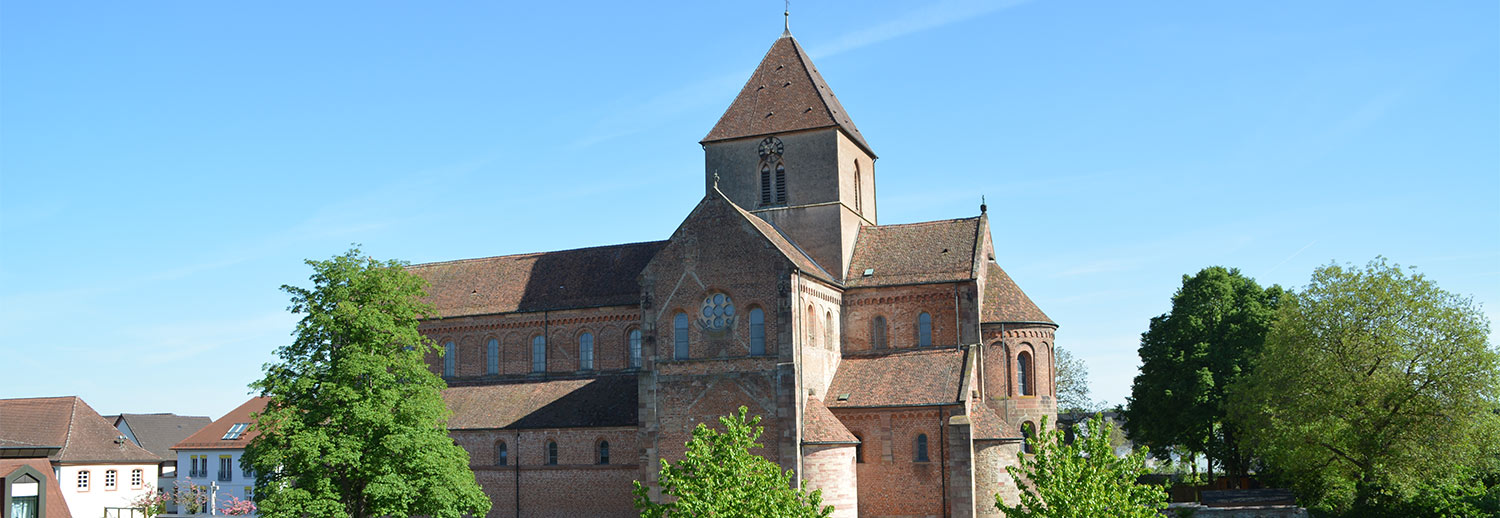




Greffern
Since time immemorial the history of Greffern has been linked to the Rhine, which has not only provided work and food, but also trouble and sorrow.A number of important discoveries from pre-history and ancient history lead us to believe that Greffern existed far before its first recorded mention in the year 1284. Today, historic names such as “Burgplatz” (Castle Square) serve as a reminder of the noble “Greffere” family who resided here in the Middle Ages, and from whom the town took its name. On the Greffern coat of arms the “punts” make reference to local fishing and the oars to navigation, whilst the roses represent water lilies. The background of the original coat of arms is a reference to the gold panning industry that once flourished in the area.
Floods devastated the town so many times that it had to be moved inland four times between the 15th and 17th centuries. Another impending move was narrowly averted at the beginning of the 19th century. Before the Rhine correction project, the floodwaters often reached “the standing height of a man and poured through the windows.”
In addition to gold panning, which was a vital source of income, fishing provided employment for many people in the region. The Rhine and many nearby “pools and lakes” were so ideal for fishing that a fisherman’s’ guild was established here in the 15th century.
Greffern’s shipping industry is no less rich in tradition. As early as 1331, appropriate laws were entered in the “City of Strasbourg Statute Book”, which also documents the subsequently flourishing passenger and freight transport activities. Even today shipping is still one of Greffern’s main industries, as demonstrated by the ships mast. Tolls were particularly important for Greffern on the federal highway and “on the Rhine”. The people of Greffern have always operated a ferry service between their town and Drusenheim on the left bank of the river: a pontoon bridge was erected in 1875, followed by the motor ferry “Drusus”, which has been providing a free ferry service since 1977.
The Greffern chapel to the Saints John and Paul was once a well-visited place of pilgrimage. The church was built in 1755 and the current place of worship was established in 1887. The parish, which became independent in 1966, was once affiliated to Schwarzach.Industry also flourishes in the town. In 1965, the world famous international company Dow Chemical set up on a site covering 75 hectares. At the same tome, quite a large number of sailors still earn their living on the international boats travelling up and down the Rhine.
Schwarzach
The development of Schwarzach is closely linked with the Benedictine abbey that existed here until 1803 and the abbey coat of arms, which consists of a key and sword, has become part of the district seal.
The abbey was mentioned for the first time in 817 in a document along with “Suarizaha” (Schwarzach) and reached its historical peak in 994 when it was granted the right to hold a market. After various smaller fires, a firestorm finally tore through the abbey church in 1299. But by 1302 the church was ceremoniously consecrated. This enormous “church fair” was the beginnings of the Schwarzach fair, which is still celebrated every year.
Although the people of Schwarzach formerly came under the mother parishes of Scherzheim or Stollhofen, the abbey soon established an independent parish. The first parish church was St. Michaels, but this was later replaced by the abbey church. The so-called internal or Schwarzach bar and the mayor’s office, where the local magistrate later resided, were originally responsible for carrying out administrative and judicial duties. However, after the closure of the abbey, these duties were assumed by the Baden authority in Schwarzach, which was finally disbanded in 1809. During the peasants’ revolt, the town and the abbey suffered a great deal at the hands of the “Schwarzach mob” from outside the town. In the Thirty Years’ War Schwarzach, like many other villages, was completely plundered and laid to waste. In the town itself, as in Hildmannsfeld, only 30 citizens survived out of a total of 110. After the war, when everything fell into “neglect”, the abbey that had stood empty for a time was presented with the relics of St. Rufina, whose Saint’s day is still celebrated every year.
Schwarzach was frequently devastated during the war with Holland: “The Imperialist soldiers wreaked terrible havoc, sometimes worse than in the Swedish war”. Its proximity to the “Bühl-Stollhofener Line” also affected Schwarzach, and during the Napoleonic wars the town had to raise considerable war duties. Following the demolition of many of the buildings, only a few domestic offices remained of “the abbey’s former splendour”, namely the large abbey gateway and the magnificent abbey cathedral, in which the famous cathedrals concerts have been held for a number of years.
Hildmannsfeld, which was first documented in 1314 as “Hildeboldsfelde”, formed a single community with Schwarzach very early in history. After the partial separation, a union with Schwarzach was formed in 1383, as represented in the district coat of arms by the “star sign of Taurus”. The chapel, which had been burned down several times, was finally rebuilt in 1732 and placed under the patronage of St. Wolfgang.
Söllingen
When Söllingen was originally documented in 1291 as “Selingen”, the name referred to the grave mound that was found in the area at the time of its foundation. When, in 1881, the grave of a noble woman was opened, burial gifts in bronze, amber and gold were found and dated back to the Hallstatt period (approximately 6 centuries BC).
Söllingen’s position on a bend in the Rhine and right on the edge of the flood zone meant that it suffered greatly. The devastation created by the Rhine as a result of high water and floods often far outweighed the benefits it brought, such as navigation. It was only with the advent of the Rhine correction scheme that the landscape and conditions of ownership on and across the Rhine began to change. Considerable changes have continued to be made in our time as a result of improvements to the Rhine such as the dam at Iffezheim.
Söllingen formerly belonged to the abbey at Schwarzach, and the inhabitants were here, as they were elsewhere, “St Peters people”. When, in the 15th century, Söllingen was sold to the margraves of Baden, changes were made to the escort station and state customs post which had been of great importance to the area since the early 14th century and in whose income many noble families on the right and left bank of the Rhine shared, as well as their owners. The noble “von Söllingen” family soon moved away to Strasbourg.
The oldest church records of the chapel and curate’s office of St. Mauritius, whose symbols are on the district coat of arms, come from the 14th century, when there were close links with the mother parish of Stollhofen. In 1700, a new section was added on to the church, and in 1805 an independent parish was set up thanks to the help of his “Electoral Highness”. Finally, in 1842, the foundation stone was laid for the present church which was designed by J. L. Weinbrenner.
Following the great devastation of the Thirty Years’ War, Söllingen was almost completely destroyed in the 1670s. In 1689, the town was drawn directly into the field of war when work began on the construction of Fort Louis on a nearby island in the Rhine. An external fort was even built to protect the town from Fort Louis, but its fortifications had to be torn down. Söllingen suffered a great deal in both the Polish and Austrian wars of succession due to its position on the Rhine, opposite Fort Louis. At the beginning of the 1790s it became a main deployment area and it was from here that a large part of the cannon assault on Fort Louis was launched in 1793. The town once again played an important role in 1814, when the allied troops crossed the Rhine here; today “Russenstraße” (Russia Street) stands as a reminder of this. The construction of an airport in 1952 also brought about a number of changes.
Stollhofen
In the past, Stollhofen has played an important role as a castle and fortress, administrative and legal headquarters, and as a mother parish. In a document from 1154 the town was referred to as “Stadelhofen” and in the 13th century the village was elevated to the status of a town. The authority of Stollhofen came into existence as early as 1472 and extended as far as Rastatt and the Upper Rhine. After several rights were transferred in 1309, Abbott Johann from the abbey in Schwarzach sold the town with all its rights in 1490/93 to Margrave Christoph von Baden. The “Baden stripe” was added to one section of the divided coat of arms, whilst in another section the key from the Schwarzach abbey coat of arms was retained. Few traces remain of the fact that Stollhofen once had one of the most well-fortified castles in the area. This was the seat of the noble “von Stollhofen” family, who were originally granted mayoral authority as a fief from the abbey of Schwarzach. Later the castle became the fiefdom of various noble families, until it was subsequently made the seat of the Margrave’s governor or official representative.
Judicial control of Stollhofen was originally exercised by the Abbey of Schwarzach and court was held on most Tuesdays in Justice Square “under the fir trees”. With the sale of Stollhofen, the law also came under the control of Baden, and the place of execution was moved outside the town to a location on the road to Lichtenau.
Due to the large amount of traffic on the “Imperial Highway” which passed through the town, Stollhofen took on an important role as an escort station. Even more sought after were the toll incomes, where the master’s customs officer collected a tax according to a precise tariff. Later the town also became an important post and relay station.
The fortified St. Cyriak basilica once stood outside the town walls. After it was completely destroyed in the Thirty Years’ War, Erhard’s chapel took over as the town’s church until 1769, when it was replaced by the baroque style St. Erhard’s parish church with its typical onion dome.
Numerous military disputes took place in and around the fortified town of Stollhofen. As in the peasants’ revolt, it played an important role in the Thirty Years’ war too, when it was conquered and laid to waste several times. However, the high point of its military history was during its fortification as the headquarters and tactical cornerstone of the battle for the “Bühl-Stollhofener-Line” during the Spanish war of succession. It was finally captured in 1707 and the fortifications razed to the ground. Today, the only reminders of this great epoch in the history of Stollhofen are the narrow buildings and the street names.
Places of historical interest – Schwarzach cathedral
Every traveller along Federal Highway 36, which crosses Rheinmünster between Rastatt and Strasbourg, can catch a glimpse of the abbey cathedral nestling on the banks of the Rhine. This magnificent colonnaded basilica is almost all that remains of the former Benedictine abbey of Schwarzach, which in the course of its colourful and tragic history between 1714 and1803 was the driving force behind the extraordinary religious, cultural and economic prosperity of the central Rhine area. The abbey was also the impetus for the emergence of Schwarzach as a town (in 828), because when the monks first came to the “Schwarze Ache” there was nothing there at all.
The architecturally imposing and historically interesting abbey cathedral is the fourth church (built 1220-1225) belonging to the former abbey. During an archaeological excavation in 1964-66, the remains of three other churches were discovered on the same site. Thousands of visitors come to visit the cathedral every year; both inside and out, if offers a wide range of interesting themes for artists and photographers to explore. Historical relics from the abbey’s past include the baroque organ which, despite erroneous claims to the contrary, is not a real “Silbermann organ”.
The baroque abbey was built during the baroque period, but was torn down almost a hundred years later and can now be seen only in pictures. Disastrous attempts were also made to make the church look more baroque. However, in 1967-69, when urgent restoration work was carried out to the church to save this gem of medieval colonnaded architecture from collapse (the last creation of the Hirsau architectural school), the opportunity was seized to reverse all the baroque alterations and to restore the abbey church to its original architectural style. Nevertheless, it still retains features from four different architectural styles: It is predominantly romantic in style, with some gothic touches on the pointed belfry windows in the tower and pointed arches on the crossing (1299-1302), the ornate carved wooden choir stalls are renaissance in style (1700) and the baroque organ and recently restored, monumental altar are from the baroque period.
Besides the monastery, only the administration and domestic offices arranged around the monastery courtyard and the monastery gateway remain of the former Benedictine abbey in Schwarzach. These were built in the period between 1761 and 1790, or probably more precisely between 1765 and 1773, as the foundation stone was laid on 29 August 1765.
From a description dated 1802, we can see that the abbey once consisted of a pulpit, guest rooms, a pharmacy with a laboratory, servants’ quarters with a kitchen, a mill, large storerooms and barns, accommodation for labourers and maid servants with cattle stalls, porters lodges, fire brigade sheds, joiners and coopers huts, as well as accommodation for the coachmen and stables.
Since 1978 the Rheinmünster council has been carrying out restoration work on this historic area in the centre of Schwarzach, as part of an extensive renovation programme. This began with the current town hall, the fire station and the former school. The monastery courtyard and cathedral square have also been renovated. These measures are being predominantly financed by the regional renovation programme, in which private property owners of former monastery buildings can also participate.
The few remaining baroque buildings only make up a small proportion of the former monastery site, but they do give us some insight into the level of influence this town must have exerted at one time. With the demolition of the central building of the abbey and convent in the 19th century, the majority of the overall complex was destroyed. However, the council is currently involved in projects to help preserve the remains for future generations.
The Rheinmünster coat of arms was awarded to the community on 21 April 1975 by the interior ministry of Baden-Württemberg. It features the former monastery coat of arms, with its key and sword. This was used in the olden days as a justice seal and, since 1900, as the Schwarzach coat of arms with its red, silver and gold colouring. It also incorporates the roses from the former Greffern coat of arms. There is also a key on the ancient coat of arms of Stollhofen, whilst the sword, a symbol of its church patron Mauritius, has always been one of the two objects depicted on the Söllingen coat of arms. The coat of arms can be described as follows:
“In blue, a silver sword with a golden hilt, diagonally crossed with a silver key, above and below it a five-leaved, blue-tinged golden rose.”




